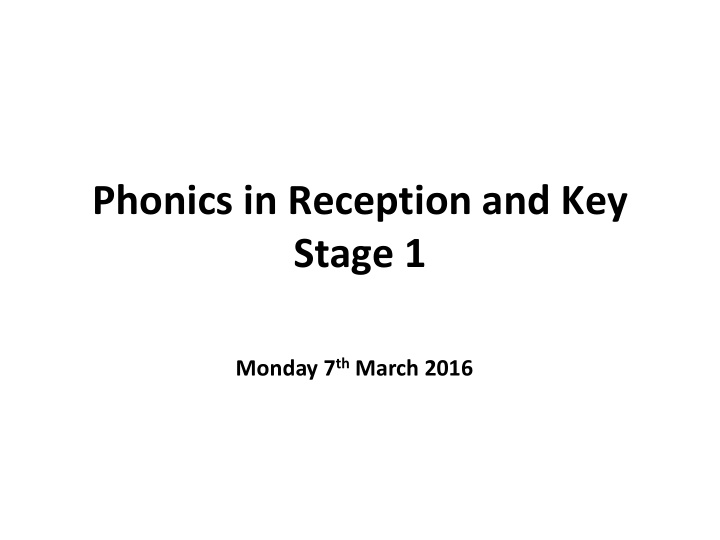



Phonics in Reception and Key Stage 1 Monday 7 th March 2016
Phonics through the week • At Foston and Terrington Primary Schools phonics is taught daily. The children do a variety of interactive activities, linking the sounds to actions, writing sounds and spelling words. • The children also do independent activities, linking what they know and have learnt in a session and applying it. • EYFS activities in the areas of provision also link to phonics • As a confederation, we base our planning on the LCP scheme of work, which is closely linked to the Government publication, Letters and Sounds. • The children also apply their phonics skills in their reading.
Phonemes and Graphemes A letter consists of; a sound, a shape and it has a capital form and a lower case form. Aa Use lower case for all writing Only use capital letters for names, and when children are ready at the beginning of sentences. Letter sound = Phoneme Letter shape = Grapheme The letter sound is the first thing that children need to recognise.
Letters and Sounds We are following Government guidance with regards to 6 phases of phonics teaching. This six phase teaching programme focuses on high quality phonic work. The Intention is to “…equip children who are 5 with the phonic knowledge and skills they need to become fluent readers by the age of 7.” By the end of Year Two children should have completed phase 6. Which phase the children should be working on is assessed by the teacher, and appropriate teaching is planned for. At the end of Year 1 children complete a Phonics screening to gauge whether they have successfully learnt their sounds. Below is information about the 6 phases, and the progression between them.
Phase 1 Children explore and experiment with sounds, differentiate between sounds and become familiar with rhyme, rhythm and alliteration (from birth to the end of Nursery). This phase continues throughout their Primary Education.
Stages of Phonological Awareness in Phase 1 Environmental sounds Instrumental sounds Body percussion Rhythm and rhyme Alliteration Voice sounds Oral blending and segmenting
Phase 2 To introduce grapheme/phoneme (letter/sound) correspondence (beginning of Reception) Children know that words are constructed from phonemes and that phonemes are represented by graphemes. They have a knowledge of a small selection of common consonants and vowels (which usually begin with s, a, t, p, i, n) and begin to put them together to read and spell CVC words
Phase 3 To teach children one grapheme for each of the 44 phonemes in order to read and spell simple regular words. (Reception) Children link sounds to letters, naming and sounding the letters of the alphabet. They hear and say sounds in the order they occur in the word and read simple words by blending the phonemes from left to right. They recognise common digraphs (e.g. th) and read some high frequency words.
Phase 4 To teach children to read and spell words containing adjacent consonants (end of Reception) Children will be able to blend and segment adjacent consonants in words and apply this skill when reading and spelling. Children will move from CVC words (pot) to CVCC words (pots) and CCVC words (spot) and then CCVCC words (spots)
Phase 5 Teaching children to recognise and use alternative ways of pronouncing the graphemes and spelling the phonemes already taught (Year One) Children will use alternative ways of pronouncing the graphemes (e.g. the ‘c’ in coat and city). Recognise an increasing number of high frequency words automatically. Knowledge and skills of phonics will be the prime approach to reading and spelling.
Phase 6 Teaching children to develop their skill and automaticity in reading and spelling, creating ever increasing capacity to attend to reading for meaning. (Year Two) Applying phonic knowledge to recognise and spell an increasing number of complex words. Read an increasing number of high and medium frequency words independently and automatically
Children should learn each letter by its sound, alongside its name. For example, the letter a – its sound is a (as in a nt) and its name is ai (as in ai m) . This will help in blending. The letters are not introduced in alphabetical order. The first group (s, a, t, p, i, n) has been chosen because they make more simple three-letter words than any other six letters. The letters b and d are introduced in different groups to avoid confusion. Sounds that have more than one way of being written are initially taught in one form only. For example, the sound ai (r ai n) is taught first, and then alternatives a-e (g a t e) and ay (d ay) follow later.
Blending Blending is the process of saying the individual sounds in a word and then running them together to make the word. For example, sounding out d- o- g and making dog . It is a technique every child will need to learn, and it improves with practice. To start with you should sound out the word and see if a child can hear it, giving the answer if necessary. Some children take longer than others to hear this. The sounds must be said quickly to hear the word. It is easier if the first sound is said slightly louder.
Blending • Some sounds (digraphs) are represented by two letters, such as sh. Children should sound out the digraph (sh) , not the individual letters ( s - h ) . With practice they will be able to blend the digraph as one sound in a word. So, a word like rain should be sounded out r-ai-n, and feet as f-ee-t. This is difficult to begin with and takes practice.
Blending Some words in English have an irregular spelling and cannot be read by blending, such as said, was and one. Unfortunately, many of these are common words. The irregular parts have to be remembered. These are called the ‘tricky words’.
Recommend
More recommend